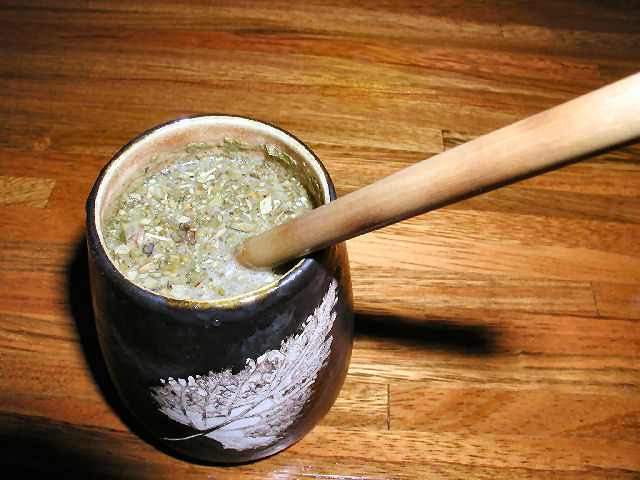NEWS
August 24, 2006

I avoided mate for my first couple of months in Argentina. Not because there was anything particularly wrong with the tea itself, though one sip of it one time left me with a bitter taste, something like tea left to stand too long. No, it was the communal nature of the experience. Imagine sitting down to your morning coffee, pouring yourself a few spoonfuls, drinking it, then pouring the same amount and passing the cup on to the next person at the breakfast table. With half a dozen folk sitting around your table, getting your morning caffeine buzz on could take hours.
Mate, or more formally, yerba mate, is the dried and chopped leaves of a shrub from the holly family, native to the Rio de la Plata part of South America. The name comes from the Quechua language, the primary ancient language of the Incas, where the herb is called mati. Many claims have been made for the health giving properties of regular ingestion of this herb, the most common of which is weight loss. It may be true, but not for any magical reasons. Yerba mate is packed with caffeine – not as much as coffee, but plenty of it. There are folks who claim that mate doesn’t contain caffeine, but instead mateine – however that’s just folklore – mateine is merely a synonym for caffeine and is chemically identical.
The same name is often used for the cup that it is prepared in, though some prefer to call it a matero. Traditionally, the mate is a hollowed out small gourd that has been dried, and the drinking straw is made from a hollow reed. In the modern day, mates are often ceramic, metal, or glass, and can be highly decorative. The straw, or bombilla, is generally wood or metal, with a fine mesh or tiny holes at the bottom to prevent sucking up pieces of leaves.
Mate is not brewed like tea – there are some serious differences. There is an art to packing the leaves into the matero, and to the placement of the bombilla. This art can sometimes get as complicated as a Japanese green tea ceremony, depending on the cebador, the person brewing it – an historic if rarely used term in casual conversation. The cebador is not always, in truth as best I can tell, not generally, the host. Instead, it’s the person who is first asked if they want to drink mate, or, if you’re too slow on the offering – a time period that extends from the moment you hang up their coats until their backsides touch down on your sofa cushion – the person who asks for it. And they will ask. Because mate, despite one’s ability to drink it alone, is a social experience, much the same as passing a peace pipe or a bottle of bourbon around the campfire. I’ve also noted that within some groups of friends, one person is always the cebador, apparently by group consensus that they pack the best cup.
Once offered, and the cebador selected, and the water put on to boil, the artist packs and then brews and drinks the first cup, ensuring that the fine particulate matter is cleared. This is also the moment when the cebador assesses your ability to select a good mate, and believe me, they’re different. I’m not quite sure what would happen if my mate didn’t pass the test. My guess is, given the social mores of porteño society, trashing the quality would be perfectly acceptable. It would no doubt become the subject of a solid ten minutes of embarrassing conversation designed to ensure that I never again repeat such a stupid mistake.
Assuming that the mate passes muster, and thankfully for my yanqui self, it always has, the cebador refills the cup and passes it to the first person, who drinks and hands it back. After that, the mate continues around in a circle, one cup at a time, each poured by the cebador, and then handed to the next person in the circle. This is a communal affair, and extraordinarily important to the bonding of not only close friends, but of host and guest. One can merely hope that no one in the circle has a communicable disease. To not partake of at least one round of the mate cup, unless one is ill, is considered poor manners. When you’ve had your fill, you hand the cup back to the host and say “gracias”, perhaps with a simple wave of the hand. The thank you is the cebador’s indication that you wish to be left out of the following rounds.
A decision is generally made by consensus whether or not to drink the mate bitter or sweet. If the former, nothing more is added, just a topping off of hot water; if the latter, a small spoonful of sugar is added each, or every few rounds of pouring. If the group has a mixed decision, the sugar drinkers generally win, and those who prefer their mate unadulterated generally wait to drink until one or two cups have been poured since the last addition of sugar.